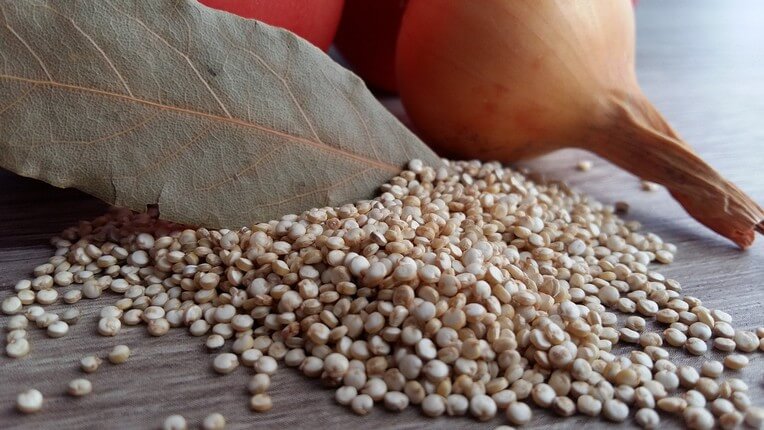Quinoa (pronounced keen-wah) is becoming more popular in our kitchens as more people realise its many benefits and how easy it is to prepare. Quinoa has been around for a while and is an ancient seed (often referred to as a grain) native to the Andes mountains in South America where it has been a staple food of the Incas for over 5,000 years.
It’s called a complete food by nutritionists because it is very high in protein, full of minerals and vitamins, it’s also gluten and wheat-free, usually organic and simply delicious!
Health benefits of quinoa
The health benefits are truly great. Quinoa is a very good source of manganese, magnesium, potassium, phosphorus, copper, zinc, vitamins E, B1, B2, B3 and B6. It has more calcium than cow’s milk, is an excellent antioxidant, is rich in dietary fibre and has more iron than any grain.
It also has the highest content of unsaturated fats and a lower ratio of carbohydrates than any other grain, plus a low Glycemic Index level.
Quinoa contains more protein than any grain and this is a complete protein meaning it contains all essential amino acids (they have to be obtained from foods and can’t be produced by the body). The quality of this protein has been likened by the World Health Organisation as being closest to milk.
The amino acid composition is so well balanced and has a particularly high content of the amino acid lysine (which is essential in our diet for tissue repair and growth), making it a must for vegans who may be concerned about the level of protein in their diet.
Cooking with quinoa
Cooked quinoa is distinctive in both taste and appearance with a lovely, slightly nutty taste. It can be substituted for just about any other grain and it has a huge range of uses. Its delicate texture is excellent in soups and desserts, and makes wonderful salads, pasta, breads and delicious vegetarian and non-vegetarian meals.
Moreover, it is simple to prepare, easy to digest and enjoyable to eat.
It is very light on the stomach and you won’t feel at all ‘heavy’ after eating a meal made with quinoa. To those who eat gluten- and wheat-free, quinoa is a food that can offer a greater variety and selection of food.
There are many varieties of quinoa and it’s available in grain form, as flakes and flour. The colour of the grain can vary from white, pale yellow to red, purple, brown or black. Quinoa is available in most health food stores or in the health section of the supermarkets.
Preparing quinoa
Quinoa has a bitter coating which must be removed before cooking. Although most quinoa is pre-washed and ready to cook, it is still a good idea to rinse it thoroughly before cooking. One part quinoa, two parts of liquid and 10 minutes in the saucepan are usually all the time needed to prepare quinoa as a basic cooked grain.
However, you need to cook the quinoa a little longer if the liquid is denser than water such as a sauce or milk.
For salads you will need to cook quinoa first and then combine with the other ingredients. You can make a large batch and keep it in the fridge to use as needed.
Quinoa cooked in water will keep in the fridge for up to a week. It is often cooked with other ingredients making easy, one-pot meals.
See Part 2 of this article for more tips and recipes.
Joanna Sochan
Holistic Health and Lifestyle Therapist
Natural and Lifestyle Solutions for Chronic Diseases
Source: ‘Cooking with quinoa the supergrain’ by Rena Patten
Check out other posts here:
- Eat this – Chia seeds
- Dinner recipe: Baked salmon with goat’s cheese and salad
- Drinking coffee – pros and cons from a medical perspective
- Gotu kola: uses and benefits for skin, stomach ulcers and memory
- Top nutrition tips for insomnia and interrupted sleep
 Joanna Sochan is a Natural Therapist and founder of Naturimedica Holistic Health & Wellness. She has a passion for helping her clients transform their lives by becoming healthy and well naturally. Joanna is a fatigue, sleep and gut health expert helping tired, stressed or unwell individuals to regain their energy, sleep better and be happier, more relaxed and calm. Joanna practices in Sydney and Lake Macquarie, Australia and also conducts online consultations for clients Australia-wide. View full bio.
Joanna Sochan is a Natural Therapist and founder of Naturimedica Holistic Health & Wellness. She has a passion for helping her clients transform their lives by becoming healthy and well naturally. Joanna is a fatigue, sleep and gut health expert helping tired, stressed or unwell individuals to regain their energy, sleep better and be happier, more relaxed and calm. Joanna practices in Sydney and Lake Macquarie, Australia and also conducts online consultations for clients Australia-wide. View full bio.
 Print This Post
Print This Post 

How do you get the bitter coating off the quinoa, is it just a matter of rinsing it? like you do with white rice to get the excess starch off it?? how long do you rinse it for. With the white rice you know you have done it enough because the white starch stops appearing in the water, what is the “measure” with quinoa?
Thanks in advance
Kaytee
Most of quinoa sold in shops is already pre-washed and without the bitter coating. However, it’s always a good idea to rinse it anyhow under running water for about 30 secs. I find this is sufficient.